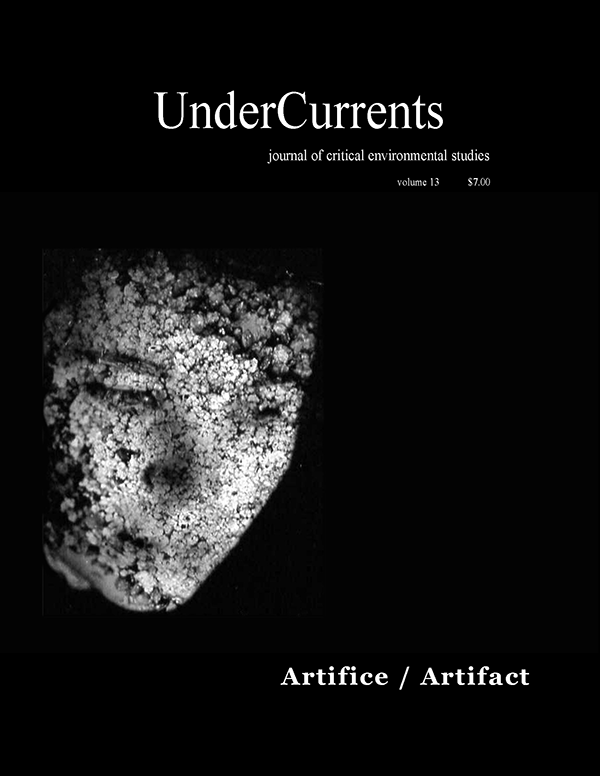The Natural Ambiguity of Native Species
DOI:
https://doi.org/10.25071/2292-4736/40416Abstract
Mainstream ecological wisdom suggests that native species are essential to the preservation and promotion of ecological health or integrity: they are often deemed to be the ‘natural’, ‘authentic’ and ‘original’ occupants of particular habitats. Philosophically and pragmatically, they are generally considered crucial to biodiversity at scales ranging from the local to global. The past five years in particular have witnessed an explosion of publications and workshops expounding the virtues of native species as the rightful residents of bioregionally defined locales, to the extent that commercial chain nurseries have even caught on and showcase native species from their stock.
References
Elliot, R. (1997). Faking Nature: The Ethics of Environmental Restoration. London: Routledge.
Evernden, N. (1992). The Social Creation of Nature. Baltimore: Johns Hopkins University Press. DOI: https://doi.org/10.56021/9780801843969
Forsyth, T. (2003). Critical Political Ecology: The Politics of Environmental Science. London: Routledge. DOI: https://doi.org/10.4324/9780203017562
Gavine, K. (1995). Natural Invaders: Invasive Plants in Ontario. Toronto: Federation of Ontario Naturalists.
Gröning, G. and Wolschke-Bulmahn, J. (2003). The Native Plant Enthusiasm: Ecological Panacea or Xenophobia? Landscape Research. v. 28, n. 1. 75-88. DOI: https://doi.org/10.1080/01426390306536
Hull, R.B. and Robertson, D.P. (2000). The language of nature matters: we need a more public ecology. In P. Gobster and R.B. Hull (Eds), Restoring Nature: Perspectives From the Social Sciences and Humanities. Washington: Island Press. 97-118.
Johnson, L. (1995). The Ontario Naturalized Garden. Toronto: Whitecap Books.
Katz, E. (2000). Another look at restoration: Technology and artificial nature. In P. Gobster and R.B. Hull (Eds), Restoring Nature: Perspectives From the Social Sciences and Humanities. Washington: Island Press. 37-48.
Leadbeater, D. (2001). So what is native anyways? In Native Plant Resource Guide. Society for Ecological Restoration - Ontario Chapter. 16
McNight, B. (Ed). (1993). Biological Pollution: The Control and Impact of Exotic Plant Species. Indianapolis: Indiana Academy of Science.
Murphy, S. (1999). Eight questions for ecological restorationists. Alternatives. v. 25, n. 2. 19-20.
Pickett, S.T.A. & Ostfeld, R.S. (1995). The shifting paradigm in Ecology. In R.L. Knight and S.F. Bates (Eds). A New Century for Natural Resource Management. Washington: Island Press. 261-278.
Pimentel, D., Lach, L., Zuniga, R., and Morrison, D. (1999). Environmental and Economic Costs Associated with Non-Indigenous Species in the United States, College of Agriculture and Life Sciences, Cornell University, Ithaca, New York. DOI: https://doi.org/10.1641/0006-3568(2000)050[0053:EAECON]2.3.CO;2
Sauer, L.J. (1998). The Once and Future Forest: A Guide to Forest Restoration Strategies. Washington: Island Press. Society for Ecological Restoration International Science and Policy Working Group. (2002). The SER Primer on Ecological Restoration. Available at: www.ser.org. Accessed 25/03/2003.
Van Driesche, J. and van Driesche, R. (2000). Nature Out of Place: Biological Invasions in the Global Age. Washington: Island Press.
Waterfront Regeneration Trust. (1995). Restoring Natural Habitats. Toronto: Waterfront Regeneration Trust.
Published
How to Cite
Issue
Section
License
Copyright (c) 2004 Jennifer FosterCreators retain copyright for all writings and artwork published in UnderCurrents. New material published as of Volume 21 (2022) is available under a Creative Commons Attribution 4.0 International License (CC-BY 4.0).


